
STS-81 Biographies
| Baker | Jett | Grunsfeld | Ivins | Wisoff | Linenger | Blaha |
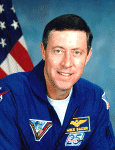 Michael
A. Baker, Commander
Michael
A. Baker, Commander
NAME: Michael A. Baker (Captain, USN) NASA Astronaut
BIRTHPLACE AND DATE: Born October 27, 1953, in Memphis, Tennessee, but considers Lemoore, California, to be his hometown. Married to the former Deidra A. Mudurian of San Francisco, California. Two children. He enjoys tennis, swimming, hiking, and running. His parents, Mr. & Mrs. Clyde E. Baker, reside in Lemoore, California. Her mother, Mrs. Patricia TeStruth, resides in San Jose, California. Her father, Mr. Myron Mudurian, resides in Akron, Ohio.
EDUCATION: Graduated from Lemoore Union High School, Lemoore, California, in 1971; received a bachelor of science degree in aerospace engineering from the University of Texas in 1975.
ORGANIZATIONS: Member of the Society of Experimental Test Pilots, Association of Naval Aviation, the Tailhook Association, Association of Space Explorers, National Aeronautic Association, Sierra Club, and Veterans of Foreign Wars. Member of the Advisory Committee to the University of Texas College of Engineering, Aerospace Engineering Department.
SPECIAL HONORS: Awarded the Defense Superior Service Medal, 2 Defense Meritorious Service Medals, the Distinguished Flying Cross, the Navy Unit Commendation, 3 Meritorious Unit Commendations, the Battle "E" Award, NASA Distinguished Service Medal, NASA Outstanding Leadership Medal, NASA Exceptional Service Medal, 4 NASA Space Flight Medals, 3 Navy Expeditionary Medals, the National Defense Medal, 2 Sea Service Awards, and the Overseas Service Award. Named 1993 Outstanding University of Texas Alumni.
EXPERIENCE: After graduation from the University of Texas, Baker completed flight training and earned his Wings of Gold at Naval Air Station Chase Field, Beeville, Texas, in 1977. In 1978, he was assigned to Attack Squadron 56, embarked in the USS Midway, homeported in Yokosuka, Japan, where he flew the A-7E Corsair II. In late 1980 he was assigned to Carrier Air Wing 30 as the air wing landing signal officer. He attended the U.S. Naval Test Pilot School in 1981 and, after graduation, was assigned to the Carrier Suitability Branch of the Strike Aircraft Test Directorate.
While there, Baker conducted carrier suitability structural tests, aircraft carrier catapult and arresting gear certification tests, and automatic carrier landing system certification and verification tests on the various aircraft carriers of the Navy's fleet in the A-7 aircraft. In 1983, he returned to the U.S. Naval Test Pilot School as an instructor. He was then assigned as the U.S. Navy exchange instructor at the Empire Test Pilots School in Boscombe Down, England, teaching performance, flying qualities and systems flight test techniques.
He has logged over 5,400 hours flying time in approximately 50 different types of airplanes, including tactical jets, VSTOL, multi-engine transport and rotary wing aircraft, and has over 300 carrier landings to his credit.
NASA EXPERIENCE: Selected by NASA in June 1985, Baker became an astronaut in July 1986 upon completion of a one-year training and evaluation program. Following the Challenger accident, from January 1986 to December 1987, Baker was assigned as a member of the team that was pursuing redesign, modification and improvements to the Shuttle Landing and Deceleration Systems, including nosewheel steering, brakes, tires, and drag chute, in an effort to provide greater safety margins during landing and rollout. He was then assigned to the Shuttle Avionics Integration Laboratory (SAIL), where he was involved in the checkout and verification of the computer software and hardware interfaces for STS-26 (the return-to-flight mission) and subsequent flights.
Baker then served as an ascent, entry and orbit spacecraft communicator (CAPCOM) for STS-27, STS-29, STS-30, STS-28, STS-34, STS-33, STS-32, STS-36, STS-31, STS-38, and STS-35. In this capacity his duties included communication with the Shuttle crew during simulations and actual missions, as well as working procedural problems and modifications between missions. He served as the leader of the Astronaut Support Personnel team at the Kennedy Space Center for Shuttle Missions STS-44, STS-42 and STS-45.
From December 1992 to January 1994 he was assigned as the Flight Crew Operations Directorate Representative to the Space Shuttle Program Office. From March to October 1995 he served as the Director of Operations for NASA at the Gagarin Cosmonaut Training Center in Star City, Russia,. He was responsible for the coordination and implementation of mission operation activities in the Moscow region for the joint U.S./Russian Shuttle/Mir program.
A veteran of four space flights, Baker has logged 965 hours in space. He served as pilot on STS-43 (August 2-11, 1991) and STS-52 (October 22 to November 1, 1992), and was the mission commander on STS-68 (September 30 to October 11, 1994) and STS-81 (January 12-22, 1997).
He is currently assigned as the Assistant Director of Johnson Space Center (JSC) for Human Space Flight Programs, Russia, responsible for implementation and integration of NASA's human space flight programs in Russia. These activities include International Space Station (ISS) training, operations, technical liaison, logistics and personnel administration support. He also serves as the NASA JSC representative to the Russian Space Agency, Gagarin Cosmonaut Training Center, Star City; Mission Control Center-Moscow, Energia Rocket and Spacecraft Corporation, Krunichev State Scientific and Production Space Center and other Russian government agencies and manufacturers involved in the ISS program.
STS-43 Space Shuttle Atlantis launched from the Kennedy Space Center, Florida, on August 2, 1991. During the flight, crew members deployed the fifth Tracking and Data Relay Satellite (TDRS-E), in addition to conducting 32 physical, material, and life science experiments, mostly relating to the Extended Duration Orbiter and Space Station Freedom. After 142 orbits of the Earth, the 9-day mission concluded with a landing on Runway 15 at the Kennedy Space Center on August 11, 1991. Mission duration was 213 hours, 21 minutes, 25 seconds.
STS-52 Space Shuttle Columbia launched from the Kennedy Space Center, Florida, on October 22, 1992. During the mission crew members deployed the Italian Laser Geodynamic Satellite (LAGEOS) which will be used to measure movement of the Earth's crust, and operated the U.S. Microgravity Payload 1 (USMP-1). Additionally, the Space Vision System (SVS) developed by the Canadian Space Agency was tested by the Canadian payload specialist and the crew using a small target assembly which was released from the remote manipulator system. The SVS will be used for Space Station construction. These three primary payloads together with numerous other payloads operated by the crew encompassed geophysics, materials science, biological research and applied research for Space Station Freedom. Following 159 orbits of the Earth, the 10-day mission concluded with a landing on Runway 33 at the Kennedy Space Center on November 1, 1992. Mission duration was 236 hours, 56 minutes, 13 seconds.
STS-68 Space Shuttle Endeavour launched from the Kennedy Space Center, Florida, on September 30, 1994. This flight was the second flight of the Space Radar Laboratory (SRL) comprised of a large radar called SIR-C/X-SAR (Shuttle Imaging Radar-C/X-Band Synthetic Aperture Radar) and MAPS (Measurement of Air Pollution from Satellites). As part of NASA's Mission to Planet Earth, SRL was an international, multidisciplinary study of global environmental change, both natural and man-made. The primary objective was to radar map the surface of the Earth to help us understand the contributions of ecology, hydrology, geology, and oceanography to changes in our Planet's environment. Real-time crew observations of environmental conditions, along with over 14,000 photographs, aided in interpretation of the radar images. This SRL mission was a highly successful test of technology intended for long-term environmental and geological monitoring of planet Earth. Following 183 orbits of the Earth, the eleven-day mission concluded with a landing on Runway 22 at Edwards Air Force Base, California, on October 11, 1994. Mission duration was 269 hours, 46 minutes, 10 seconds.
STS-81 Space Shuttle Atlantis launched from the Kennedy Space Center, Florida on January 12, 1997. STS-81 was the fifth in a series of joint missions between the U.S. Space Shuttle and the Russian Space Station Mir and the second one involving an exchange of U.S. astronauts. In five days of docked operations more than three tons of food, water, experiment equipment and samples were moved back and forth between the two spacecraft. Following 160 orbits of the Earth the STS-81 mission concluded with a landing on Kennedy Space Center's Runway 33 ending a 3.9 million mile journey. Mission duration was 244 hours, 56 minutes.
_______________________________________________________________
| Baker | Jett | Grunsfeld | Ivins | Wisoff | Linenger | Blaha |
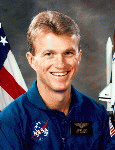 Brent
W. Jett, Jr., Pilot
Brent
W. Jett, Jr., Pilot
NAME: Brent W. Jett, Jr. (Commander, USN) NASA Astronaut
PERSONAL DATA: Born October 5, 1958, in Pontiac, Michigan, but considers Ft. Lauderdale, Florida, to be his hometown. Married to Janet Leigh Lyon of Patuxent River, Maryland. He enjoys water and snow skiing, board sailing, boating, running, basketball, squash. His parents, Mr. & Mrs. Brent W. Jett, Sr., reside in Ft. Lauderdale, Florida. Her mother, Mrs. Mary Patricia Lyon, resides in Fredericksburg, Virginia. Her father, Mr. James Richard Lyon, Sr., is deceased.
EDUCATION: Graduated from Northeast High School, Oakland Park, Florida, in 1976; received a bachelor of science degree in aerospace engineering from the U.S. Naval Academy in 1981; a master of science degree in aeronautical engineering from the U.S. Naval Postgraduate School in 1989.
ORGANIZATIONS: Society of Experimental Test Pilots, Association of Naval Aviation, U.S. Naval Academy Alumni Association, Association of Space Explorers.
SPECIAL HONORS: Graduated first of 976 in the Class of 1981 at U.S. Naval Academy; Distinguished Graduate U.S. Naval Test Pilot School Class 95. Awarded the Department of Defense Superior Service and Meritorious Service Medals, Navy Commendation Medal, NASA Exceptional Service Medal, 2 NASA Space Flight Medals, and various other service awards.
EXPERIENCE: Jett received his commission from the U.S. Naval Academy in May 1981 and was designated a Naval Aviator in March 1983. He then reported to Fighter Squadron 101 at Naval Air Station Oceana, Virginia Beach, Virginia, for initial F-14 Tomcat training. Upon completion of this training, he was assigned to Fighter Squadron 74 and made overseas deployments to the Mediterranean Sea and Indian Ocean aboard the USS Saratoga (CV-60).
While assigned to Fighter Squadron 74, he was designated as an airwing qualified landing signal officer (LSO) and also attended the Navy Fighter Weapons School (Topgun). Jett was selected for the Naval Postgraduate School - Test Pilot School Cooperative Education Program in July 1986, and completed 15 months of graduate work at Monterey, California, before attending the U.S. Naval Test Pilot School in June 1989.
After graduation in June 1990, he worked as a project test pilot at the Carrier Stability Department of the Strike Aircraft Test Directorate, Naval Air Test Center, flying the F-14A/B/D, T-45A, and A-7E. Jett returned to the operational Navy in September 1991 and was again assigned to Fighter Squadron 74, flying the F-14B aboard the USS Saratoga (CV-60). Jett was deployed with VF-74 to the Mediterranean Sea when selected for the astronaut program.
He has logged over 3,500 flight hours in more than 30 different aircraft and has over 450 carrier landings.
NASA EXPERIENCE: Selected by NASA in March 1992, Jett reported to the Johnson Space Center in August 1992. After 2-years of various technical assignments in the Astronaut Office, Jett was assigned to his first mission as the pilot of STS-72. During the 9-day flight (January 11-20, 1996) aboard Endeavour, the crew retrieved the Space Flyer Unit (launched from Japan 10-months earlier), deployed and retrieved the OAST-Flyer, and conducted two spacewalks to demonstrate and evaluate techniques to be used in the assembly of the International Space Station.
He also was the pilot on STS-81 (January 12-22, 1997). STS-81 was the fifth in a series of joint missions between the U.S. Space Shuttle and the Russian Space Station Mir and the second one involving an exchange of U.S. astronauts. In five days of docked operations more than three tons of food, water, experiment equipment and samples were moved back and forth between the two spacecraft. Twice flown, he has orbited the Earth 302 times, traveled 7.6 million miles, and logged a total of 458 hours and 56 minutes in space.
From June 1997 to February 1998, he served as NASA Director of Operations at the Yuri Gagarin Cosmonaut Training Center, Star City, Russia. Jett is assigned to command the crew of Endeavour for STS-97, the fifth American mission to build and enhance the capabilities of the International Space Station. STS-97 will deliver the first set of U.S.-provided solar arrays and batteries as well as radiators to provide cooling. The Shuttle will spend 5-days docked to the station. Two spacewalks will be conducted to complete assembly operations while the arrays are attached and unfurled. A communications system for voice and telemetry also will be installed. Launch is targeted for the winter of 2000.
_______________________________________________________________
| Baker | Jett | Grunsfeld | Ivins | Wisoff | Linenger | Blaha |
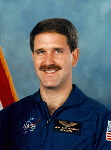 John
M. Grunsfeld, Mission Specialist
John
M. Grunsfeld, Mission Specialist
NAME: John M. Grunsfeld (Ph.D.) NASA Astronaut
PERSONAL DATA: Born October 10, 1958, in Chicago, Illinois. Married to the former Carol E. Schiff. They have two children. He enjoys mountaineering, flying, sailing, bicycling, and music. His parents, Ernest and Sally Grunsfeld, reside in Highland Park, Illinois. Her parents, David and Ruth Schiff, reside in Highland Park, Illinois.
EDUCATION: Graduated from Highland Park High School, Highland Park, Illinois, in 1976; received a bachelor of science degree in physics from the Massachusetts Institute of Technology in 1980; a master of science degree and a doctor of philosophy degree in physics from the University of Chicago in 1984 and 1988, respectively.
ORGANIZATIONS: American Astronomical Society.
SPECIAL HONORS: W.D. Grainger Fellow in Experimental Physics, 1988-89. NASA Graduate Student Research Fellow, 1985-87. NASA Space Flight Medals (1995, 1997, 1999). NASA Exceptional Service Medals (1997, 1998).
EXPERIENCE: Dr. Grunsfelds academic positions include that of Visiting Scientist, University of Tokyo/Institute of Space and Astronautical Science (1980-81); Graduate Research Assistant, University of Chicago (1981-85); NASA Graduate Student Fellow, University of Chicago (1985-87); W.D. Grainger Postdoctoral Fellow in Experimental Physics, University of Chicago (1988-89); and Senior Research Fellow, California Institute of Technology (1989-92). Dr. Grunsfelds research has covered x-ray and gamma-ray astronomy, high energy cosmic ray studies, and development of new detectors and instrumentation. Dr. Grunsfeld studies binary pulsars and energetic x-ray and gamma-ray sources using the NASA Compton Gamma Ray Observatory, x-ray astronomy satellites, radio telescopes, and optical telescopes.
NASA EXPERIENCE: Dr. Grunsfeld was selected by NASA in March 1992, and reported to the Johnson Space Center in August 1992. He completed one year of training and is qualified for flight selection as a mission specialist. Dr. Grunsfeld was initially detailed to the Astronaut Office Mission Development Branch.
Following his first flight, he led a team of engineers and computer programmers tasked with defining and producing the crew displays for command and control of the International Space Station (ISS). As part of this activity he directed an effort combining the resources of the Mission Control Center (MCC) Display Team and the Space Station Training Facility. The result was the creation of the Common Display Development Facility (CDDF), responsible for the onboard and MCC displays for the ISS, using object-oriented programming techniques.
Following his second flight he was assigned as Chief of the Computer Support Branch in the Astronaut Office supporting Space Shuttle and International Space Station Programs and advanced technology development. A veteran of three space flights, STS-67 in 1995, STS-81 in 1997, and STS-103 in 1999, Grunsfeld has logged over 835 hours in space, including two space walks totaling 16 hours and 23 minutes.
He is currently assigned to upgrade and service the Hubble Space Telescope during the STS-109 mission scheduled for launch in 200l .
STS-67 Astro-2 (March 2-18,1995) was the second flight of the Astro observatory, a unique complement of three telescopes. During this record-setting 16-day mission, the crew conducted observations around the clock to study the far ultraviolet spectra of faint astronomical objects and the polarization of ultraviolet light coming from hot stars and distant galaxies. Mission duration was 399 hours and 9 minutes.
STS-81 (January 12-22, 1997) was a ten-day mission, the fifth to dock with Russias Space Station Mir, and the second to exchange U.S. astronauts. The mission also carried the Spacehab double module providing additional middeck locker space for secondary experiments. In five days of docked operations more than three tons of food, water, experiment equipment and samples were moved back and forth between the two spacecraft. Following 160 orbits of the Earth the STS-81 mission concluded with a landing on Kennedy Space Centers Runway 33 ending a 3.9 million mile journey. Mission duration was 244 hours, 56 minutes.
STS-103 (December 19-27, 1999) was an 8-day mission during which the crew successfully installed new instruments and upgraded systems on the Hubble Space Telescope (HST). Enhancing HST scientific capabilities required three space walks (EVA). Grunsfeld performed two space walks totaling 16 hours and 23 minutes. The STS-103 mission was accomplished in 120 Earth orbits, traveling 3.2 million miles in 191 hours and 11 minutes.
_______________________________________________________________
| Baker | Jett | Grunsfeld | Ivins | Wisoff | Linenger | Blaha |
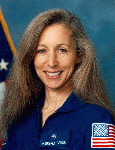 Marsha
S. Ivins, Mission Specialist
Marsha
S. Ivins, Mission Specialist
NAME: Marsha S. Ivins NASA Astronaut
PERSONAL DATA: Born April 15, 1951, in Baltimore, Maryland. She enjoys flying, baking. Her parents, Dr. and Mrs. Joseph L. Ivins, reside in Wallingford, Pennsylvania.
EDUCATION: Graduated from Nether Providence High School, Wallingford, Pennsylvania, in 1969; received a bachelor of science degree in aerospace engineering from the University of Colorado in 1973.
NASA EXPERIENCE: Ms. Ivins has been employed at the Lyndon B. Johnson Space Center since July 1974, and until 1980, was assigned as an engineer, Crew Station Design Branch, working on Orbiter Displays and Controls and Man Machine Engineering. Her major assignment in 1978 was to participate in development of the Orbiter Head-Up Display (HUD). In 1980 she was assigned as a flight engineer on the Shuttle Training Aircraft (Aircraft Operations) and a co-pilot in the NASA administrative aircraft (Gulfstream-1).
Ms. Ivins holds a multi-engine Airline Transport Pilot License with Gulfstream-1 type rating, single engine airplane, land, sea, and glider commercial licenses, and airplane, instrument, and glider flight instructor ratings. She has logged over 5,700 hours in civilian and NASA aircraft.
Ms. Ivins was selected in the NASA Astronaut Class of 1984 as a mission specialist. Her technical assignments to date include: crew support for Orbiter launch and landing operations; review of Orbiter safety and reliability issues; avionics upgrades to the Orbiter cockpit; software verification in the Shuttle Avionics Integration Laboratory (SAIL); Capsule Communicator (CAPCOM) in Mission Control; crew representative for Orbiter photographic system and procedures; crew representative for Orbiter flight crew equipment issues; Lead of Astronaut Support Personnel team at the Kennedy Space Center in Florida, supporting Space Shuttle launches and landings; crew representative for Space Station storage logistics transfer issues. A veteran of four space flights, (STS-32 in 1990, STS-46 in 1992, STS-62 in 1994, and STS-81 in 1997), Ms. Ivins has logged over 1009 hours in space.
Ms. Ivins is assigned to STS-98. The crew will continue the task of building and enhancing the International Space Station by delivering the U.S. laboratory module. The Shuttle will spend six days docked to the station while the laboratory is attached and three spacewalks are conducted to complete its assembly. The STS-98 mission will occur while the first station crew is aboard the new spacecraft. Launch is targeted for 2001.
STS-32 (January 9-20, 1990) launched from the Kennedy Space Center, Florida, on an eleven-day flight, during which crew members onboard the Orbiter Columbia successfully deployed a Syncom satellite, and retrieved the 21,400 pound Long Duration Exposure Facility (LDEF). Mission duration was 261 hours, 1 minute, and 38 seconds. Following 173 orbits of the Earth and 4.5 million miles, Columbia returned with a night landing at Edwards Air Force Base, California.
STS-46 (July 31-August 8, 1992) was an 8-day mission, during which crew members deployed the European Retrievable Carrier (EURECA) satellite, and conducted the first Tethered Satellite System (TSS) test flight. Mission duration was 191 hours, 16 minutes, and 7 seconds. Space Shuttle Atlantis and her crew launched and landed at the Kennedy Space Center, Florida, completing 126 orbits of the Earth in 3.35 million miles.
STS-62 (March 4-18, 1994) was a 14-day mission for the United States Microgravity Payload (USMP) 2 and Office of Aeronautics and Space Technology (OAST) 2 payloads. These payloads studied the effects of microgravity on materials sciences and other space flight technologies. Other experiments onboard included demonstration of advanced teleoperator tasks using the remote manipulator system, protein crystal growth, and dynamic behavior of space structures. Mission duration was 312 hours, 23 minutes, and 16 seconds. Space Shuttle Columbia launched and landed at the Kennedy Space Center, Florida, completing 224 orbits in 5.82 million miles.
STS-81 (January 12-22, 1997) was a 10-day mission, the fifth to dock with Russia's Space Station Mir, and the second to exchange U.S. astronauts. The mission also carried the Spacehab double module providing additional middeck locker space for secondary experiments. In five days of docked operations more than three tons of food, water, experiment equipment and samples were moved back and forth between the two spacecraft. Following 160 orbits of the Earth the STS-81 mission concluded with a landing on Kennedy Space Center's Runway 33 ending a 3.9 million mile journey. Mission duration was 244 hours, 56 minutes.
_______________________________________________________________
| Baker | Jett | Grunsfeld | Ivins | Wisoff | Linenger | Blaha |
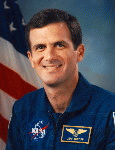 Peter
J. K. Wisoff, Mission Specialist
Peter
J. K. Wisoff, Mission Specialist
NAME: Peter J.K. "Jeff" Wisoff (Ph.D) NASA Astronaut
PERSONAL DATA: Born August 16, 1958, in Norfolk, Virginia. Married to Tamara E. Jernigan. He enjoys scuba diving, racquetball, swimming, and sailing. His parents, Carl & Pat Wisoff, reside in Norfolk.
EDUCATION: Graduated from Norfolk Academy, Norfolk, Virginia, in 1976; received a bachelor of science degree in physics (with Highest Distinction) from University of Virginia in 1980, a master of science degree and a doctorate in applied physics from Stanford University in 1982 and 1986 respectively.
SPECIAL HONORS: NASA Space Flight Medals (1993, 1994, 1997); NCR Faculty Award of Excellence (1989); National Science Foundation Graduate Fellowship 1980-1983; Physics Prize and Shannon Award from the University of Virginia (1980). Selected to Phi Beta Kappa in 1979.
EXPERIENCE: After graduating from the University of Virginia in 1976, Dr. Wisoff began his graduate work on the development of short wavelength lasers at Stanford University as a National Science Foundation Graduate Fellow. Upon completing his master's and doctorate degrees at Stanford in 1986, Dr. Wisoff joined the faculty of the Electrical and Computer Engineering Department at Rice University. His research focused on the development of new vacuum ultraviolet and high intensity laser sources. In addition, he also collaborated with researchers from regional Texas Medical Centers on the applications of lasers to the reconstruction of damaged nerves. He has recently collaborated with researchers at Rice University on new techniques for growing and evaluating semiconductor materials using lasers. Dr. Wisoff has contributed numerous papers at technical conferences and in journals in the areas of lasers and laser applications.
NASA EXPERIENCE: Selected by NASA in January 1990, Dr. Wisoff became an astronaut in July 1991. He is qualified for flight assignment as a mission specialist. His technical assignments to date include: spacecraft communicator (CAPCOM) in Mission Control; flight software verification in the Shuttle Avionics Integration Laboratory (SAIL); coordinating flight crew equipment; evaluating extravehicular activity (EVA) equipment and techniques for the construction of Space Station; lead for the Payloads and Habitability Branch of the Astronaut Office.
A veteran of four space flights, STS-57 in 1993, STS-68 in 1994, STS-81 in 1997 and STS-92 in 2000, Dr. Wisoff has logged a total of 42 days, 56 hours, 1 minute and 48 seconds in space, including 19 hours and 53 minutes of EVA time in three space walks.
STS-57 Endeavour (June 21 to July 1, 1993) launched from and returned to land at the Kennedy Space Center, Florida. The primary objective of this flight was the retrieval of the European Retrievable Carrier satellite (EURECA) using the RMS. Additionally, this mission featured the first flight of Spacehab, a commercially-provided middeck augmentation module for the conduct of microgravity experiments. Spacehab carried 22 individual flight experiments in materials and life sciences research. During the mission Wisoff conducted a 5-hour, 50-minute spacewalk during which the EURECA communications antennas were manually positioned for latching, and various extravehicular activity tools and techniques were evaluated for use on future missions. STS-57 was accomplished in 155 orbits of the Earth in 239 hours and 45 minutes.
STS-68 Endeavour (September 30 to October 11, 1994) was the Space Radar Lab-2 (SRL-2) mission. As part of NASAs Mission to Planet Earth, SRL-2 was the second flight of three advanced radars called SIR-C/X-SAR (Spaceborne Imaging Radar-C/X-Band Synthetic Aperture Radar), and a carbon-monoxide pollution sensor, MAPS (Measurement of Air Pollution from Satellites). SIR-C/X-SAR and MAPS operated together in Endeavours cargo bay to study Earths surface and atmosphere, creating radar images of Earths surface environment and mapping global production and transport of carbon monoxide pollution. Real-time crew observations of environmental conditions, along with over 14,000 photographs aided the science team in interpreting the SRL data. The SRL-2 mission was a highly successful test of technology intended for long-term environmental and geological monitoring of planet Earth. Following 183 orbits of the Earth in 269 hours and 46 minutes, the eleven-day mission ended with Space Shuttle Endeavour landing at Edwards Air Force Base, California.
STS-81 Atlantis (January 12-22, 1997) was a ten-day mission, the fifth to dock with Russias Space Station Mir, and the second to exchange U.S. astronauts. The mission also carried the Spacehab double module providing additional middeck locker space for secondary experiments. In five days of docked operations more than three tons of food, water, experiment equipment and samples were moved back and forth between the two spacecraft. Following 160 orbits of the Earth in 244 hours, 55 minutes, the STS-81 mission concluded with a landing on Kennedy Space Centers Runway 33 ending a 3.9 million mile journey.
_______________________________________________________________
| Baker | Jett | Grunsfeld | Ivins | Wisoff | Linenger | Blaha |
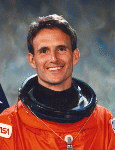 Jerry
M. Linenger, NASA-4 Mir Resident
Jerry
M. Linenger, NASA-4 Mir Resident
NAME: : J. M. Linenger, M.D., M.S.S.M., M.P.H., Ph.D. (Captain, Medical Corps, USN) NASA Astronaut
PERSONAL DATA: Born January 16, 1955, and raised in Eastpointe, Michigan. Married to the former Kathryn M. Bartmann of Arlington Heights, Illinois. They have two sons. He enjoys competitive triathalons, ocean swim racing, marathons, downhill and cross-country skiing, scuba diving, backpacking, camping. Siblings include Kenneth Linenger, Susan Barry, Karen Brandenburg, and Barbara Vallone, all residing in Michigan. His mother, Frances J. Linenger, resides in Eastpointe, Michigan. His father, Donald W. Linenger, is deceased.
EDUCATION: Graduated from East Detroit High School, Eastpointe, Michigan, in 1973; received a bachelor of science degree in bioscience from the U.S. Naval Academy in 1977; a doctorate in medicine from Wayne State University in 1981; a master of science degree in systems management from University of Southern California in 1988; a master of public health degree in health policy from the University of North Carolina in 1989; a doctor of philosophy degree in epidemiology from the University of North Carolina in 1989.
ORGANIZATIONS: The U.S. Naval Academy, University of Southern California, Wayne State University School of Medicine, and University of North Carolina Alumni Associations; the Association of Naval Aviation; the U. S. Navy Flight Surgeons Association; the Aerospace Medicine Association; the American Medical Association; the American College of Preventive Medicine; the Society of U.S. Navy Preventive Medicine Officers; and the American College of Sports Medicine. Linenger is board certified in preventive medicine.
SPECIAL HONORS: Awarded the Meritorious Unit Commendation; Navy Unit Commendation; National Defense Service Medal; Navy Battle Efficiency Award; Navy Commendation Medal with gold star; and 2 NASA Space Flight Medals. Top graduate, Naval Flight Surgeon Training and Naval Safety Officer's School. Elected to Phi Kappa Phi and Alpha Omega Alpha academic honor societies. Distinguished Alumni Award, Wayne State University School of Medicine. Gihon Award, Society of Naval Preventive Medicine Officers.
EXPERIENCE: Linenger graduated from the U.S. Naval Academy and proceeded directly to medical school. After completing surgical internship training at Balboa Naval Hospital, San Diego, California, and aerospace medicine training at the Naval Aerospace Medical Institute, Pensacola, Florida, he served as a naval flight surgeon at Cubi Point, Republic of the Philippines. He was then assigned as medical advisor to the Commander, Naval Air Forces, U.S. Pacific Fleet, San Diego. After completing doctorate-level training in epidemiology, Linenger returned to San Diego as a research principal investigator at the Naval Health Research Center. He concurrently served as a faculty member at the University of California-San Diego School of Medicine in the Division of Sports Medicine.
NASA EXPERIENCE: Linenger joined astronaut selection Group XIV at the Johnson Space Center in August 1992. He flew on STS-64 (September 9-20, 1994) aboard the Space Shuttle Discovery. Mission highlights included: first use of lasers for environmental research; deployment and retrieval of a solar science satellite; robotic processing of semiconductors; use of an RMS-attached boom for jet thruster research; first untethered spacewalk in 10 years to test a self-rescue jetpack. In completing his first mission, Linenger logged 10 days, 22 hours, 51 minutes in space, completed 177 orbits, and traveled over 4.5 million miles.
Following his first mission, he began training at the Cosmonaut Training Center in Star City, Russia, in preparation for a long-duration stay aboard the Russian Space Station Mir. All training was conducted using the Russian language, and consisted of learning all Mir Space Station systems (life support/electrical/communication/attitude control/computer systems), simulator training, Soyuz launch/return vehicle operations, and spacewalk water tank training. He also trained as chief scientist to conduct the entire US science program, consisting of over one-hundred planned experiments in various disciplines. A sampling includes: medicine (humoral immunity, sleep monitoring, radiation dosimetry), physiology (spatial orientation/performance changes during long duration flight), epidemiology (microbial surface sampling), metallurgy (determination of metal diffusion coefficients), oceanography/geology/limnology/physical science (photographic survey (over 10,000 photos) of the planet), space science (flame propagation), microgravity science (behavior of fluids, critical angle determination).
Linenger launched aboard U.S. Space Shuttle Atlantis (STS-81) on January 12, 1997, remained onboard the space station with two Russian cosmonauts upon undocking of the Shuttle, and eventually returned upon a different mission of Atlantis (STS-84) on May 24, 1997-spending a total of 132 days, 4 hours, 1 minute in space-the longest duration flight of an American male to date. During his stay aboard space station Mir, Linenger became the first American to conduct a spacewalk from a foreign space station and in a non-American made spacesuit.
During the five hour walk, he and his Russian colleague tested for the first time ever the newly designed Orlan-M Russian-built spacesuit, installed the Optical Properties Monitor (OPM) and Benton dosimeter on the outer surface of the station, and retrieved for analysis on Earth numerous externally-mounted material-exposure panels. The three crewmembers also performed a "flyaround" in the Soyuz spacecraft-undocking from one docking port of the station, manually flying to and redocking the capsule at a different location-thus making Linenger the first American to undock from a space station aboard two different spacecraft (U.S. Space Shuttle and Russian Soyuz).
While living aboard the space station , Linenger and his two Russian crewmembers faced numerous difficulties-the most severe fire ever aboard an orbiting spacecraft, failures of onboard systems (oxygen generator, carbon dioxide scrubbing, cooling line loop leaks, communication antenna tracking ability, urine collection and processing facility), a near collision with a resupply cargo ship during a manual docking system test, loss of station electrical power, and loss of attitude control resulting in a slow, uncontrolled "tumble" through space. In spite of these challenges and added demands on their time (in order to carry out the repair work), they still accomplished all mission goals-spacewalk, flyaround, and one-hundred percent of the planned U.S. science experiments.
In completing the nearly five month mission, Linenger logged approximately 50 million miles (the equivalent of over 110 roundtrips to the Moon and back), more than 2000 orbits around the Earth, and traveled at an average speed of 18,000 miles per hour. Because of the flawless launch, docking, undocking, and landing of the Space Shuttle Atlantis (STS-84) crew-exchange mission, he made it back to the planet just in time to be reunited with Kathryn and to witness the birth of their second son.
_______________________________________________________________
| Baker | Jett | Grunsfeld | Ivins | Wisoff | Linenger | Blaha |
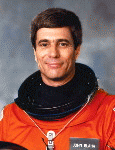 John
E. Blaha, NASA-3 Mir Resident
John
E. Blaha, NASA-3 Mir Resident
NAME: John E. Blaha (Colonel, USAF, Ret.) NASA Astronaut
PERSONAL DATA: Born August 26, 1942, in San Antonio, Texas. Married to the former Brenda I. Walters of St. Louis, Missouri. They have three grown children and two grandchildren.
EDUCATION: Graduated from Granby High School in Norfolk, Virginia, in 1960; received a bachelor of science in engineering science from the United States Air Force Academy in 1965 and a master of science in astronautical engineering from Purdue University in 1966.
ORGANIZATIONS: Association of Space Explorers; Purdue Alumni Association; Society of Experimental Test Pilots; Air Force Academy Association of Graduates; Chairman, Board of Directors Brooks Aerospace Foundation; Member, Committee on Engineering Challenges to the Long Term Operation of the International Space Station, National Research Council Aeronautics and Space Engineering Board.
SPECIAL HONORS: Russian Order of Friendship Medal, 2 NASA Distinguished Service Medals, NASA Outstanding Leadership Medal, NASA Exceptional Service Medal, 5 NASA Space Flight Medals, Countdown Magazine Outstanding Astronaut of 1991, Defense Superior Service Medal, Legion of Merit, 2 Air Force Distinguished Flying Crosses, Defense Meritorious Service Medal, 3 Meritorious Service Medals, 18 Air Medals, Air Force Commendation Medal, the British Royal Air Force Cross, the Vietnam Cross of Gallantry, Purdue Outstanding Aerospace Engineer Award, and the Purdue Engineering Alumnus Award. Outstanding Pilot, F-4 Combat Crew Training. Outstanding Junior Officer of the Year, 3rd Tactical Fighter Wing. Distinguished Graduate Air Force Test Pilot School. Distinguished Graduate Air Command and Staff College. University Roundtable Annual Best and Brightest Award. Grand Marshall Fiesta Flambeau Parade. Grand Marshall Battle of Flowers Parade. Granby High School Hall of Fame.
EXPERIENCE: Blaha received his pilot wings at Williams Air Force Base, Arizona, in 1967. He was subsequently assigned as an operational pilot flying F-4, F-102, F-106, and A-37 aircraft (completing 361 combat missions in Vietnam). He attended the USAF Aerospace Research Pilot School at Edwards Air Force Base, California, in 1971, and piloted the NF-104 research aircraft to 104,400 feet. Following graduation, he served as an F-104 instructor pilot at the test pilot school, teaching low lift-to-drag approach, zoom, performance, stability/control, and spin flight test techniques.
In 1973, he was assigned as a test pilot working with the Royal Air Force at the Aeroplane and Armament Experimental Establishment, Boscombe Down, United Kingdom. During a 3-year tour, he flew stability/control, performance, spin, and weapons delivery flight tests in the Jaguar, Buccaneer, Hawk, and Jet Provost aircraft. In 1976 he attended the USAF Air Command and Staff College. After graduation, he was assigned to work for the Assistant Chief of Staff, Studies and Analyses, at Headquarters USAF in the Pentagon. During this tour, he presented F-15 and F-16 study results to Department of Defense, State Department, and congressional staffs.
NASA EXPERIENCE: Selected as an astronaut in May 1980, Blaha has logged 161 days in space on 5 space missions. He served as pilot on STS-33 and STS 29, was Spacecraft Commander on STS-58 and STS-43, served on Mir-22 as Board Engineer 2, and was a Mission Specialist on STS-79 and STS-81.
In addition to flying 5 space missions, Blaha has served as the Chairman, NASA Space Flight Safety Panel; Weather Manager, Mission Management Team; lead spacecraft communicator; member, NASA Space Shuttle Improvement Panel. Blaha also led the design, development, and integration of the Orbiter Head Up Display system. Additionally, he led the development of contingency abort procedures which significantly improve crew survivability in the event of multiple main engine failures during ascent.
He has logged more than 7,000 hours of flying time in 34 different aircraft, and has written numerous technical articles on spacecraft performance and control.
John Blaha retired from NASA in September 1997 to return to his hometown of San Antonio, Texas, where he joined the Executive Management Group of the United Services Automobile Organization.
STS-29 Discovery launched from Kennedy Space Center, Florida, on March 13, 1989, and landed at Edwards Air Force Base on March 18, 1989. During this very successful mission the five-man crew aboard Shuttle Discovery deployed the East Tracking and Data Relay Satellite, and performed eight scientific/medical experiments.
STS-33 Discovery (November 22-27, 1989). Launched at night, this five-day mission carried Department of Defense payloads and other secondary payloads. After 79 orbits of the Earth, this highly successful mission concluded with a hard surface landing on Runway 4 at Edwards Air Force Base, California.
STS-43 Atlantis (August 2-11, 1991) launched from the Kennedy Space Center carrying a five person crew. During the nine-day mission the crew deployed the West Tracking and Data Relay Satellite, and conducted 32 physical, material, and life science experiments that supported the development of the Extended Duration Orbiter and Space Station. After 142 orbits of the Earth, this very significant mission concluded with a landing on Runway 15 at the Kennedy Space Center, Florida.
STS-58 Columbia (October 18 to November 1, 1993) launched from the Kennedy Space Center carrying a seven-person crew. This record duration fourteen-day life science research mission has been recognized by NASA management as the most successful and efficient Spacelab flight that NASA has flown. The crew performed neurovestibular, cardiovascular, cardiopulmonary, metabolic, and musculoskeletal medical experiments on themselves and 48 rats, expanding our knowledge of human and animal physiology both on Earth and in space flight. In addition, the crew performed 16 engineering tests aboard the Orbiter Columbia and 20 Extended Duration Orbiter Medical Project experiments. Landing was at Edwards Air Force Base on Runway 22.
Blaha began Russian language training in August 1994 at the Defense Language Institute in Monterey, California, and commenced an intensive training program at the Cosmonaut Training Center, Star City, Russia in January 1995. He launched on STS-79 on September 16, 1996. After docking he transferred to the Mir Space Station. Assigned as a Board Engineer 2, he spent the following 4 months with the Mir-22 Cosmonaut crew conducting material science, fluid science, and life science research. Blaha returned to Earth aboard STS-81 on January 22, 1997.